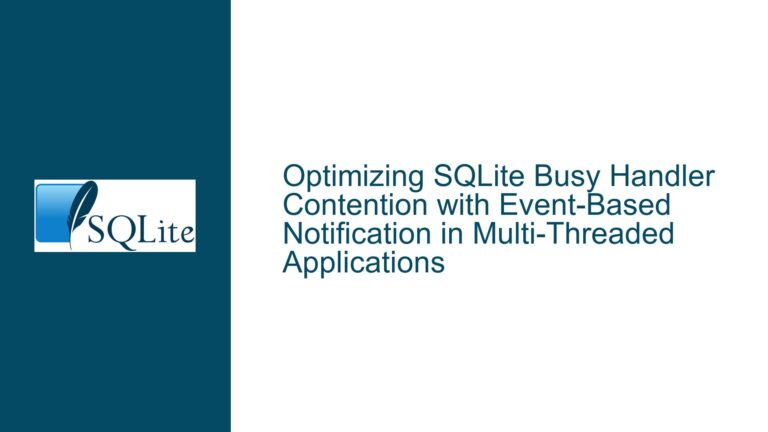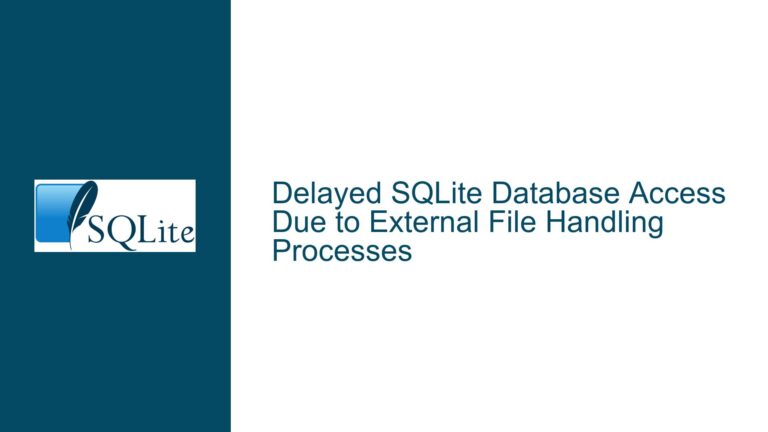Is It Safe to Run VACUUM on a New SQLite Database Connection?
SQLite VACUUM Fails Due to Unfinalized Statements or Open Transactions
The SQLite VACUUM command is a powerful tool for optimizing database performance by defragmenting the database file and reclaiming unused space. However, its execution is not always straightforward, especially in multi-threaded applications or environments with concurrent database access. A common issue arises when VACUUM fails due to unfinalized SQL statements or open transactions on the same or other database connections. This problem is particularly prevalent in applications where multiple threads or processes interact with the database simultaneously, leading to contention over locks and resources.
When VACUUM is executed, it requires exclusive access to the database to perform its operations. This means that no other connections can hold write locks, and all read transactions must be finalized. If any connection has an open transaction or an unfinalized statement, VACUUM will fail with an error indicating that some statements are still running. This error can be frustrating, especially in complex applications where tracking down the exact source of the open transaction or unfinalized statement is challenging.
One proposed solution is to run VACUUM on a new, dedicated database connection. This approach isolates the VACUUM operation from other ongoing database activities, potentially avoiding conflicts with open transactions or unfinalized statements on other connections. However, this raises questions about the safety and effectiveness of running VACUUM on a new connection. Specifically, developers need to understand whether this approach will lead to a properly defragmented database and whether it will interfere with other running statements or transactions.
Interrupted Write Operations and Unfinalized Statements Leading to VACUUM Failures
The primary cause of VACUUM failures in SQLite is the presence of unfinalized SQL statements or open transactions on the database. When a statement is executed but not finalized, it holds a read transaction open, preventing VACUUM from acquiring the necessary locks to perform its operations. Similarly, if another connection holds a write lock, VACUUM will be blocked until the lock is released. These issues are exacerbated in multi-threaded applications, where multiple threads may be executing queries simultaneously, making it difficult to ensure that all statements are properly finalized and all transactions are committed or rolled back.
Another contributing factor is the improper management of database connections. In some applications, connections are opened and closed frequently, leading to inefficiencies and potential issues with transaction management. For example, if a connection is closed without finalizing all statements or committing/rolling back transactions, it can leave the database in an inconsistent state, causing VACUUM to fail. Additionally, if connections are shared among multiple threads without proper synchronization, it can lead to race conditions and contention over locks, further complicating the execution of VACUUM.
The use of connection pooling can mitigate some of these issues by reusing connections rather than opening and closing them frequently. However, connection pooling must be implemented carefully to ensure that connections are properly managed and that statements are finalized and transactions are committed or rolled back before returning the connection to the pool. Failure to do so can result in the same issues as frequent connection opening and closing, leading to VACUUM failures.
Implementing Connection Isolation and Proper Transaction Management for Successful VACUUM Operations
To address the issues surrounding VACUUM failures in SQLite, developers can take several steps to ensure that the operation is executed safely and effectively. The first step is to isolate the VACUUM operation on a new, dedicated database connection. This approach minimizes the risk of conflicts with other ongoing database activities, as the new connection will not have any unfinalized statements or open transactions. However, it is important to note that VACUUM on a new connection will still need to wait for any existing locks held by other connections to be released before it can proceed. This means that while the new connection isolates the VACUUM operation, it does not completely eliminate the need for proper transaction management on other connections.
To ensure that VACUUM can proceed without interruption, developers should implement proper transaction management practices across all database connections. This includes finalizing all statements and committing or rolling back all transactions before attempting to run VACUUM. In multi-threaded applications, this can be challenging, but it is essential for maintaining database consistency and preventing VACUUM failures. One approach is to use the sqlite3_next_stmt() interface or the SQLITE_STMT virtual table to identify and finalize any unfinalized statements before running VACUUM. This can help ensure that no read transactions are left open, allowing VACUUM to acquire the necessary locks.
Another important consideration is the timing of VACUUM operations. Running VACUUM during periods of low database activity, such as during app startup or shutdown, can reduce the likelihood of conflicts with other database operations. Additionally, setting a timeout on database connections can help prevent long-running transactions from blocking VACUUM indefinitely. By configuring a reasonable timeout, developers can ensure that VACUUM will eventually proceed, even if other connections are holding locks for an extended period.
In cases where frequent VACUUM operations are not necessary, developers may choose to run VACUUM less frequently, such as once a month or once a year. This can reduce the impact of VACUUM on database performance and minimize the risk of conflicts with other database operations. However, it is important to monitor database fragmentation and performance to determine the optimal frequency for VACUUM operations.
Finally, developers should consider the use of connection pooling to manage database connections more efficiently. By reusing connections rather than opening and closing them frequently, connection pooling can reduce the overhead associated with establishing new connections and improve overall database performance. However, connection pooling must be implemented carefully to ensure that connections are properly managed and that statements are finalized and transactions are committed or rolled back before returning the connection to the pool. This can help prevent VACUUM failures and ensure that the database remains in a consistent state.
In conclusion, running VACUUM on a new database connection can be a safe and effective way to defragment an SQLite database, provided that proper transaction management practices are followed. By isolating the VACUUM operation, finalizing all statements, and managing database connections carefully, developers can ensure that VACUUM runs successfully and that the database remains optimized for performance. Additionally, by timing VACUUM operations appropriately and using connection pooling, developers can minimize the impact of VACUUM on database performance and reduce the risk of conflicts with other database operations.






